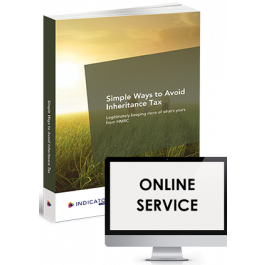Simple Ways to Avoid Inheritance Tax
Legitimately keeping more of what’s yours from HMRC
A Tips & Advice book about...
In a nutshell
Effective inheritance tax (IHT) planning can save your family a fortune. With plenty of tips and real life examples, this book helps you optimise the tax position when passing on your wealth. It explains what steps you can take to legitimately put your assets beyond HMRC's grasp. This new edition has been fully updated to include all the current tax rates and the latest tax-saving advice.
In detail
In plain English, this book tells you all you need to know about IHT:
- When IHT is due
- How IHT is calculated
- Which assets could be liable to IHT
- What tax reliefs you can safely benefit from
- Business property relief
- Agricultural property relief
- Fall in value relief
- Quick succession relief
- How to get the most out of the nil rate band
- How to make use of tax-free gifts
- Giving to charity
- The importance of wills
Make sure your loved ones are taken care of; don't miss out on this indispensable guide to IHT.
We've created this Tips & Advice book especially for...
Anyone that wants to:
- Take full advantage of IHT exemptions and reliefs
- Preserve their wealth for the next generation
Tax advisors that want to:
- Advise their clients what steps they can take to legitimately save on IHT
You'll get the following free extras with this Tips & Advice book...
An online service with ready-to-use documents
- To immediately apply our advice and solutions in practice
- That you can easily adapt to suit your own requirements
In this Tips & Advice book you'll read about...
Table of contents
1. Introduction to IHT
1.1. Which transactions trigger IHT?
1.2. What’s a disposition?
1.3. Are all individuals chargeable to IHT?
1.4. What are the special domicile rules for IHT?
1.5. How do rules differ for lifetime gifts and those made from your estate after death?
1.6. Are there special rules for trusts?
1.7. Can companies be liable to IHT?
1.8. How is a transfer valued for IHT?
2. Transfer of value
2.1. Introduction
2.2. Transfers outside the scope of IHT
2.3. Exempt transfers
2.4. Excluded property
2.5. Sales at undervalue
2.6. Associated transfers
3. Valuation
3.1. How is a transfer valued for IHT?
3.2. What’s the value of your estate?
3.3. How is the reduction of value calculated?
3.4. Related property
3.5. What does “market value” of an asset mean?
3.6. How are land and buildings valued?
3.7. How are shares and other securities valued?
3.8. How are life policies valued?
3.9. How are debts dealt with for IHT?
4. Calculation
4.1. What triggers an IHT bill?
4.2. What’s the “accumulation of transfers” rule?
4.3. What IHT reliefs are there?
5. Chargeable lifetime transfers
5.1. How does IHT apply to lifetime transfers?
5.2. What is taper relief?
5.3. When is a gift a chargeable lifetime transfer?
5.4. How does IHT apply to chargeable lifetime transfers?
5.5. How much IHT is payable on a CLT?
5.6. How is the additional tax payable worked out?
5.7. How does the seven-year rule work?
6. Potentially exempt transfers
6.1. How do PETs and CLTs differ?
6.2. Are PETs cumulative in the same way as CLTs?
6.3. How does the annual exemption interact with a PET?
6.4. How is the IHT on death worked out?
7. Taper relief
7.1. When does taper relief apply?
7.2. How much will IHT be reduced by taper relief?
8. The estate at death
8.1. What are the IHT consequences of death?
8.2. Are there IHT exemptions that apply on bequests?
8.3. Assets
8.4. What’s the position in the case of insolvency?
8.5. When do special valuation rules apply?
9. Getting the most out of the nil rate band
9.1. After valuing the estate - what next?
9.2. Is the deemed transfer on death a net or gross transfer?
9.3. What is the “transferable nil rate band”?
9.4. How is the TNRB calculated?
9.5. What effect does remarriage have on the nil rate band?
9.6. How are lifetime gifts and transfers affected by the TNRB?
9.7. Is a TNRB available for a non-domiciled spouse?
9.8. How is the TNRB claimed?
9.9. Will HMRC accept a late claim?
9.10. What is the main residence nil rate band?
10. Post-death tax planning
10.1. Can a will be changed?
10.2. How can the terms of a will be altered?
10.3. What are variations or disclaimers?
10.4. What does “express wishes of the testator” mean?
10.5. What’s a survivorship clause?
10.6. What are the effects of a court order that changes the terms of a will?
10.7. What’s the IHT position on money paid from a trust created by a will?
11. Paying the tax
11.1. What are legacies?
11.2. How is IHT calculated on a specific gift?
12. Business property relief
12.1. When does business property relief apply?
12.2. How much BPR?
12.3. Which types of assets are excluded from BPR?
12.4. What does “wholly or mainly” mean?
12.5. Does BPR apply to property rental businesses?
12.6. How long must an asset be owned before BPR applies?
12.7. What is the special rule for associated shares in unquoted companies?
12.8. How is BPR calculated on replacement assets?
12.9. How does the two-year rule apply where you inherit a business?
12.10. How is BPR affected if an asset is being sold?
12.11. What are excepted assets?
12.12. What are the effects of BPR?
12.13. Are there special rules for valuing business property?
12.14. How does BPR affect the calculation of IHT?
12.15. How do lifetime transfers qualifying for BPR affect IHT payable on death?
12.16. How is BPR calculated on replacement business property?
13. Agricultural property relief
13.1. What is agricultural property relief?
13.2. Does it matter where the property is located?
13.3. What property can qualify for APR?
13.4. Who can claim APR?
13.5. What are the rules for replacement property?
13.6. Is APR due where a property that’s been inherited is transferred?
13.7. Are there ownership and occupation concessions for successive transfers?
13.8. Will APR be allowed if the property is up for sale?
13.9. How does APR work in practice?
13.10. What does “agricultural value” mean?
13.11. What deductions must be made from the agricultural value?
13.12. How does APR affect the calculation of IHT?
13.13. Any additional rules for lifetime transfers?
13.14. Is APR due on replacement property?
13.15. How does APR interact with BPR?
13.16. What is IHT the woodlands relief?
14. Reliefs for falls in value and quick succession
14.1. Is IHT relief due when the value of an asset falls?
14.2. How is the relief applied to lifetime transfers?
14.3. How are assets valued?
14.4. Do all assets qualify for the relief?
14.5. How is the relief worked out?
14.6. Does BPR or APR affect the relief?
14.7. How are assets valued for fall in value relief?
14.8. What are the rules for assets sold following an inheritance?
14.9. What is quick succession relief?
15. Wills and why they are important
15.1. Why should you make a will?
15.2. How will your estate be divided if you don’t leave a will?
15.3. Simple tax planning using a will
16. Making use of tax-free gifts
16.1. How can making regular gifts help reduce IHT?
16.2. How much can you give away?
16.3. What if your income drops?
16.4. What are the general rules?
16.5. How can HMRC’s advice help with IHT planning?
16.6. Can you use exemptions in combination?
16.7. Can you use the annual exemption and the small gifts exemption together?
16.8. Who needs to know about your IHT planning?
17. Insurance policies
17.1. Why are life insurance policies important?
17.2. What’s the right type of policy?
17.3. Can life assurance proceeds be liable to IHT?
18. Reduce your inheritance tax bill by giving to charity
18.1. When do gifts to charity affect IHT?
18.2. What charities does this apply to?
18.3. How is the 10% benchmark calculated?
18.4. Can estate components be merged?
18.5. Can a will be varied to increase the charitable bequest?
19. Practical points
19.1. Business property relief for investors
19.2. Making gifts in the right order
19.3. Joint accounts and the death estate
19.4. Putting pension benefits in trust
19.5. Making gifts - some practical points
19.6. Deeds of variation
20. Case studies
20.1. Case study 1 - Family maintenance
20.2. Case study 2 - Deeds of variation
20.3. Case study 3 - Small gifts exemption
20.4. Case study 4 - Keeping your estate in check
20.5. Case study 5 - Taper relief trap
20.6. Case study 6 - Making gifts in the right order
20.7. Case study 7 - Wills - IHT planning
20.8. Case study 8 - Gifts out of income
21. Appendices
21.1. Appendix 1 - Intestacy rules
21.2. Appendix 2 - List of tax cases concerning business property relief
New edition coming soon
Our editors are currently finalising a new edition of this publication.
Please contact our Customer Services department for more information and/or to pre-order the new edition now.
Click here for our contact details.


 (01233) 653500
(01233) 653500 






